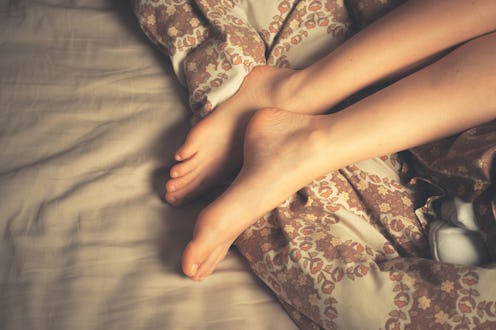Fashion
How To Heal Your Cracked Feet In Time For Spring

I realize it might be hard for all you north-easterners to imagine beach weather right now what with the Snowpocalypse and all (thanks for taking one for the team, BTW), but spring and summer are coming (however slowly they might be). And the coming of these warmer months means one thing (OK, maybe more than one thing, but for the purpose of this article, one thing): sandals. Oh yeah, soon enough it'll be time to crack off those boots that have frozen to your feet and trade them in for some strappy sandals. But how to get rid of those cracked heels and dry feet? Even though it's significantly warmer here in NC, my heavily socked-and-slippered tootsies are impatiently awaiting the return of 80-degree days; especially because of the effect the weather has on my skin.
Despite the skin on feet being generally tougher than the rest of the skin on the body, it is still affected in the same way. That means all this cold, dry air and the heating used to counteract it are all working to dry out your feet along with the rest of you. And even though summer is still a ways away (le sigh) it's really never too early to start healing dry feet because it can lead to itchiness, painful cracks, and even skin conditions like dermatitis and psoriasis. Prevention is easier than correction, though, so if your feet are still holding up alright, make sure to exfoliate and moisturize on a regular basis. That is, try to exfoliate about three times a week, and make sure to moisturize after every shower so your feet won't have you all like...
But instead like...
If the dryness has already started to take over though, or you've noticed some cracking, here are the steps to take to reverse any damage:
1. Soak it Out
Once a week, soak your feet in lemon juice for about 10 minutes. The light acidity will help break down the dead skin, so you can easily buff it away after your soak. Remember to always follow this with moisturizer or the next trick.
2. Use an Overnight Treatment
When moisturizer is not enough, it's time for an overnight treatment. Before going to bed, slather your feet in some vegetable oil or petroleum jelly and pull on a pair of thick socks. They should feel softer come morning, but you might have to do this for a few nights before you see serious results.
3. Change Your Diet
Dry feet can not only be an indicator that you are inadequately hydrated but also that you are missing some essential nutrients in your diet. To make sure your dry feet are not a result of your diet, try to drink enough water everyday, and ensure that you are consuming enough zinc and omega-3 fatty acids. These will help your feet stay hydrated and smooth.
Images: LoloStock/Fotolia; Giphy (5)